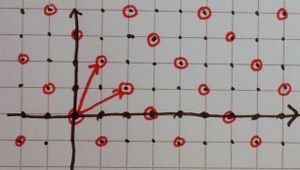Notes:Homology
From Maths
Revision as of 18:59, 11 October 2016 by Alec (Talk | contribs) (FOUND MY ERROR - no wonder it made no sense!)
Contents
Definitions
- Boundary operator: [ilmath]\partial_n:C_n\rightarrow C_{n-1} [/ilmath] given by [ilmath]\partial_n:[a_0,\ldots a_n]\mapsto\sum^n_{i=0}(-1)^i[a_0,\ldots,\hat{a_i},\ldots,a_n][/ilmath]
- [ilmath]\mathbf{n} [/ilmath]-cycles: [ilmath]Z_n[/ilmath] (a cycle is defined to have boundary 0, thus [ilmath]Z_n=\text{Ker}(\partial_n)[/ilmath] - todo - discussion)
- [ilmath]\mathbf{n} [/ilmath]-boundaries: [ilmath]B_n[/ilmath] (the image of [ilmath]\partial_{n+1} [/ilmath] - all boundaries)
- Claim: [ilmath]B_n\le Z_n[/ilmath] (that is: [ilmath]B_n[/ilmath] is a subgroup of [ilmath]Z_n[/ilmath])
- [ilmath]\mathbf{n} [/ilmath]th homology group: [ilmath]H_n:=Z_n/B_n[/ilmath]
Examples 1: [ilmath]G_1[/ilmath]
Chain complex: [ilmath]\xymatrix{
0 \ar[r]^{\partial_2} & C_1 \ar[r]^{\partial_1} \ar@2{->}[d] & C_0 \ar[r]^{\partial_0=0} \ar@2{->}[d] & 0 \\
& {\langle a,b,c,d\rangle\cong\mathbb{Z}^4} & {\langle x,y,z\rangle\cong\mathbb{Z}^3}
}[/ilmath]
[ilmath]\partial_1:C_1\rightarrow C_0[/ilmath] morphism:
- We have:
- [ilmath]\partial_1(a)= y-x[/ilmath],
- [ilmath]\partial_1(b)= z-y[/ilmath],
- [ilmath]\partial_1(c)= x-z[/ilmath] and
- [ilmath]\partial_1(d)=x-z[/ilmath] also
- We extend this to a group homomorphism by defining:
- [ilmath]\begin{array}{rcl}\partial_1(\alpha a+\beta b+\gamma c+\delta d)&:=&\alpha\partial_1(a)+\beta\partial_1(b)+\gamma\partial_1(c)+\delta\partial_1(d)\\ & =& \alpha(y-x)+\beta(z-y)+(\gamma+\delta)(x-z)\\& = &(-\alpha+\gamma+\delta)x+(\alpha-\beta)y+(\beta-\gamma-\delta)z\end{array}[/ilmath], we may write: [ilmath]\begin{pmatrix}x\\y\\z\end{pmatrix}=\alpha\left(\begin{array}{c}-1\\ 1 \\ 0\end{array}\right)+\beta\begin{pmatrix}0\\-1\\1\end{pmatrix}+\gamma\begin{pmatrix}1\\0\\-1\end{pmatrix}+\delta\begin{pmatrix}1\\0\\-1\end{pmatrix}=\begin{pmatrix}-1 & 0 & 1 & 1 \\ 1 & -1 & 0 & 0 \\ 0 & 1 & -1 & -1\end{pmatrix}\begin{pmatrix}\alpha\\\beta\\\gamma\\\delta\end{pmatrix}[/ilmath]
- Recall also the rank plus nullity theorem:
- For [ilmath]f\in\mathcal{L}(V,W)[/ilmath] we have [ilmath]\text{Dim}(\text{Ker}(f))+\text{Dim}(\text{Im}(f))=\text{Dim}(V)[/ilmath]
Computing the homology groups:
- [ilmath]H_0:=Z_0/B_0=\text{Ker}(\partial_0)/\text{Im}(\partial_1)[/ilmath]
- Computing [ilmath]\text{Ker}(\partial_0)[/ilmath] (result: [ilmath]\text{Ker}(\partial_0)=C_0[/ilmath])
- By definition, [ilmath]\partial_0:[a_0]\mapsto 0[/ilmath], so everything in the domain of [ilmath]\partial_0[/ilmath] is in the kernel!
- Thus [ilmath]Z_0=C_0[/ilmath]
- Computing [ilmath]\text{Im}(\partial_1)[/ilmath]
- It is clear from the rank plus nullity theorem mentioned above that we should have [ilmath]\text{Dim}(\text{Ker}(\partial_1))+\text{Dim}(\text{Im}(\partial_1))=4[/ilmath] and we'll need to compute the kernel of [ilmath]\partial_1[/ilmath] for [ilmath]H_1[/ilmath] anyway.
- See computing the kernel of [ilmath]\partial_1[/ilmath] below
- The dimension of the kernel is [ilmath]2[/ilmath] so the dimension of the image is [ilmath]2[/ilmath] also!
- [ilmath]H_0=\langle x,y,z\rangle/\langle \text{hmm.... thing of dimension 2...}\rangle\cong\mathbb{Z}\ (?)[/ilmath]
- It is clear from the rank plus nullity theorem mentioned above that we should have [ilmath]\text{Dim}(\text{Ker}(\partial_1))+\text{Dim}(\text{Im}(\partial_1))=4[/ilmath] and we'll need to compute the kernel of [ilmath]\partial_1[/ilmath] for [ilmath]H_1[/ilmath] anyway.
- Computing [ilmath]\text{Ker}(\partial_0)[/ilmath] (result: [ilmath]\text{Ker}(\partial_0)=C_0[/ilmath])
- [ilmath]H_1:=Z_1/B_1:=\text{Ker}(\partial_1)/\text{Im}(\partial 2)[/ilmath]
- Computing [ilmath]\text{Ker}(\partial_1)[/ilmath] has already been done below
- Computing [ilmath]\text{Im}(\partial_2)[/ilmath] is easy, it's [ilmath]0[/ilmath] - the trivial group
- Thus:
- [ilmath]H_1\cong\text{Ker}(\partial_1)=\langle a+b+c,a+b+d\rangle\cong\mathbb{Z}^2[/ilmath]
Computing the kernel of [ilmath]\partial_1[/ilmath]
To do this we wish to solve:
- [ilmath]\begin{pmatrix}-1 & 0 & 1 & 1 \\ 1 & -1 & 0 & 0 \\ 0 & 1 & -1 & -1\end{pmatrix}\begin{pmatrix}\alpha\\\beta\\\gamma\\\delta\end{pmatrix}=\begin{pmatrix}0\\0\\0\end{pmatrix}[/ilmath], which basically amounts to rrefing [ilmath]\begin{pmatrix}-1 & 0 & 1 & 1 & 0\\ 1 & -1 & 0 & 0 & 0\\ 0 & 1 & -1 & -1 & 0\end{pmatrix}[/ilmath] giving us [ilmath]\begin{pmatrix}1 & 0 & -1 & -1 & 0\\ 0 & 1 & -1 & -1 & 0 \\ 0 & 0 & 0 & 0 &0\end{pmatrix}[/ilmath]
- Yielding: [ilmath]\alpha=\gamma+\delta[/ilmath] and [ilmath]\beta=\gamma+\delta[/ilmath]. Let [ilmath]\gamma:=s[/ilmath] and then:
- [ilmath]\alpha=s+t[/ilmath] and [ilmath]\beta=s+t[/ilmath], vectorially:
- If [ilmath]\begin{pmatrix}\alpha\\\beta\\\gamma\\\delta\end{pmatrix}=s\begin{pmatrix}1\\1\\1\\0 \end{pmatrix}+t\begin{pmatrix}1\\1\\0\\1 \end{pmatrix}[/ilmath] then [ilmath]\begin{pmatrix}\alpha\\\beta\\\gamma\\\delta\end{pmatrix}\in\text{Ker}(\partial_1)[/ilmath]
- This makes perfect sense, it means (informally) [ilmath]s[/ilmath] times through [ilmath](a\rightarrow b\rightarrow c)[/ilmath] and [ilmath]t[/ilmath] times through [ilmath]a\rightarrow b\rightarrow d[/ilmath], which goes [ilmath]s+t[/ilmath] times through both [ilmath]a[/ilmath] and [ilmath]b[/ilmath] all together!
- Clearly the dimension is 2.
- Yielding: [ilmath]\alpha=\gamma+\delta[/ilmath] and [ilmath]\beta=\gamma+\delta[/ilmath]. Let [ilmath]\gamma:=s[/ilmath] and then:
Dealing with generated spaces
I don't like being so informal, hence "rings and modules"
